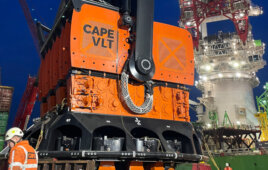
These tethers are intended to survive extended salt water and chlorine exposure. The retractable tethers are almost jam-free with a mechanism that self clears sand and other debris from the retractor mechanism. Long lasting and tough, with more than one million systems in use, the devices have a failure rate of less than 0.001%.
To prevent injury, damage, or loss, and comply with OSHA regulations, all tools used aloft must be secured against accidental displacement — dropping them. But when working aloft requires an assortment of tools, hanging multiple tethers from an employee or structure can create a potentially dangerous working environment.
The patented Quick Connect tool tether lets users safely change out a tool in seconds. To unplug a tool from the tether, a user simply selects the next tool to use, plugs it in and returns to work. The Quick Release component comes in an assortment of configurations including split ring, mini-lanyard straps, side release, bungee strap, snap clip, and more.
“Change the tool, not the tether,” says John Salentine, VP and co-founder of Hammerhead Industries, manufacturer of Gear Keeper systems. “When you consider the difficulties of working aloft, safety comes first. A tangle of tethers doesn’t make sense.”
The company’s tool and instrument tethers are versatile in other ways. Depending on the tool or application, the tethers come in retractable and lanyard styles. They can be attached to a user’s wrist, tool belt, shoulder strap, or tool carrier. For heavier tools or instruments, tethers can be anchored to a structure. In both situations, the company’s line of over 3,000 tethering configurations offers users dozens of attachment methods including a variety of carabiners, rotating belt clips, Velcro, shoulder straps, pin mounts, and snap clips. The retractable devices also come in multiple forces to match the weight of the tool or instrument.
Gear Keeper
gearkeeper.com
Filed Under: News, Safety




